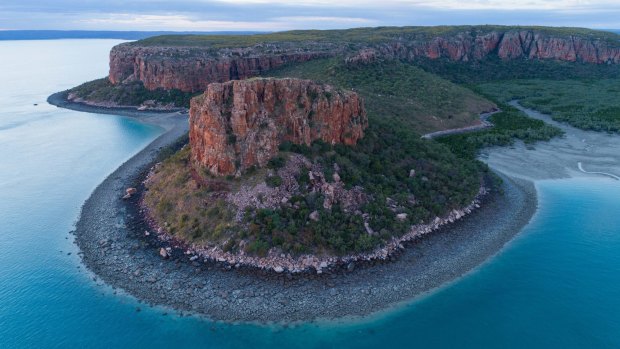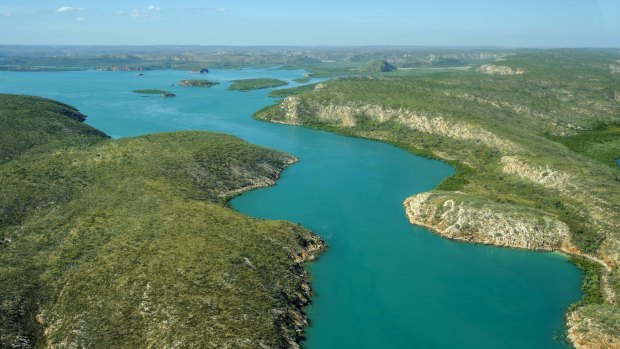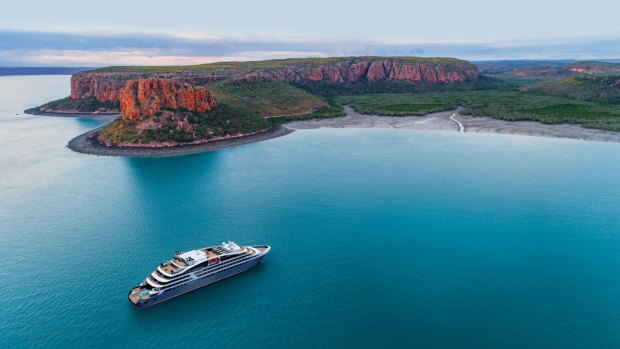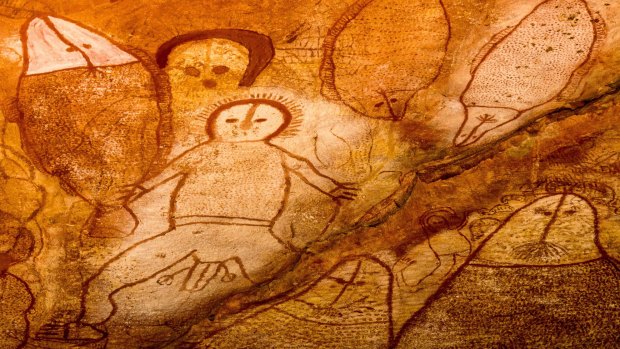This was published 5 years ago
Western Australia: Where to see one of the world's oldest art galleries
By Sue Williams

Raft Point, Kimberley Coast, Australia.Credit: Shutterstock
People travel from around the world to see some of the most provocative modern art on Earth at Tasmania's MONA but, at the other end of the country, the oldest art on Earth is also on display – and in its rawest original setting.
It's not easy to see; it involves a cruise around the Buccaneer Archipelago of Western Australia's faraway Kimberley, landing on a beach and then hiking, and climbing steep inclines, up to remote rock galleries purposely chosen to keep their contents hidden from view. But inside … their ancient treasures are simply breathtaking.
Here are some of the oldest artworks painted, scratched and gouged by humanity, telling the time-worn stories of creation, of prehistoric life, of animals, of sea turtles and fish, of hunting, fighting, loving and trading.

Buccaneer Archipelago, The Kimberley, Western Australia.Credit: Shutterstock
There's the original drawing, painted in blood-red ochre, of the famed halo-ed spirit god Wandjina, which became known globally when an enormous 12-metre-high version rose up in the 2000 Olympics opening ceremony, and then appeared lit on the sails of the Opera House during the 2016 Vivid Sydney.
There are the spindly stick figures of the Gwion Gwion, enormous kangaroos, turtles, snakes and hand prints, all daubed in reds, browns, oranges, yellow, white clay and charcoal on the King Leopold sandstone, among the oldest geological matter on earth.
"It's astonishing, isn't it?" says naturalist Tim Harvey, a guest lecturer on the Ponant-APT-Traveller cruise of the region, as he stands in the golden cavern of one of the galleries on Jar Island at Vansittart Bay. "The dye dissolved into whatever rock surface it was painted onto, until it became part of the rock itself."

Raft Point in the Kimberley.
Even more astonishing is the fact that the public are barred from visiting caves in Spain and France where some of the world's other most ancient rock art – dating back an estimated 37,000 years – have been found. But the oldest of all on earth, this rock art in Australia, which is thought to date back up to 60,000 years, has been left open for anyone to see, as well as to the sun, wind and rain.
It's a special experience too, to view Aboriginal art in its original place and form. Seeing it replicated in city galleries can be fascinating, but beholding it as an integral part of the landscape, exactly where it was created, is simply wondrous.
Experts believe there are hundreds of such galleries hidden all over this section of the Kimberley coastline, and the art is now receiving much more attention from the outside world, from art and antiquity specialists, academics and archaeologists.

Images of Wandjina, Dreamtime creator spirits, can be seen at Raft Point, Western Australia.Credit: Shutterstock
The biggest project of its type ever launched is now attempting to date the art more accurately, using an increasing range of sophisticated techniques and tools, such as Optically Stimulate Luminescence and Uranium Series Dating, with the Kimberley Foundation Australia
The best-known four sets of galleries in the Kimberley can each be visited as part of a Darwin to Broome (or vice versa) cruise, with an APT charter of a Ponant small expedition luxury ship.
On Jar Island, there's Gwion Gwion-style art – formerly known as Bradshaw art after the first English pastoralist to see them in the 1880s – of human figures with all manner of ornamentation, carrying spears, boomerangs and dilly bags. It's a good walk up to this cave, but enormously satisfying to see the images on the walls and ceiling of overhanging rocks, and how they change as the light grows stronger and fades.
Another prominent site is on Bigge Island, with its three galleries high on the cliff face scattered with Wandjina rock art and images thought to be from the locals' first contact with visitors coming from other lands by boat. These figures depicted are a lot more substantial with halo headdresses that are considered "creator beings'' or spirit gods, responsible for bringing rain and fertility blessings.
These images even inspired Swiss writer Erich von Daniken, who championed a theory that extra-terrestrials visited earth and left calling cards in the form of early human culture, to suggest these images were actually of spacemen.
Raft Point, further along the coast, is another area with a fabulous Aboriginal rock art gallery. The paintings here are regularly renewed, and touched up, by the descendants of the families of the original artists to ensure they continue to make as strong an impact on those viewing them as possible.
Finally, Freshwater Cove has its own rock art too, and the custodians of the land, the Worrorra people are a vibrant part of the artistic culture and tradition, making their own artworks on canvas for sale.
"Many are images of the Dreamtime – the creation time and spirits," says expedition leader Mick Fogg. "Others are images of the dreaming, the beliefs and totems and what they represent.
"And more are of their living traditions, with pictures of kangaroos, turtles or fish, which acted as road signs for others to tell them these are good places for hunting or fishing. While they're all very old, and show different styles, they're part of a very sophisticated system."
THE SEA TURTLE MUSES
It's little wonder that sea turtles feature so strongly in Aboriginal art – they're a species estimated to be more than 100 million years old, inhabiting the oceans at the same time as dinosaurs roamed the land.
Yet while they have such a distinguished past, there's a great deal of concern about whether they'll even have a future. The number of green turtles, for instance, has plummeted from 60 million 300 years ago to about 60,000 adults around the world today, a figure still steadily declining.
When we see one shyly put its head up over the water by the Montgomery Reef to peer at us in a zodiac, for instance, there's a huge amount of excitement since they're now endangered internationally, with the Australian government classifying them as vulnerable. It's the same when we see tracks from baby turtles leading to the sea … shadowed by those of something appreciably larger.
"There are seven species of sea turtle and they're all struggling now," says Tim Harvey, who's also the co-founder of the Sea Turtle Foundation, formed 12 years ago to educate people about the creatures, undertake research and lobby to save them.
"They're a bit like a canary in a coalmine. You might see them washing up and you then know the environment they're in isn't good, but most are killed through hunting, habitat destruction, are a by-catch from fishing and by boat strikes. But they're a precious part of the eco-system, and it's important they're looked after."
The green turtles are the most numerous of the species in Australian waters and visitors to the Kimberley can often see female turtles come ashore to lay their eggs in nesting sites up and down the 12,000-kilometre stretch of coast mostly around October and November. Then, two to three months later, the tiny turtles hatch and start their headlong rush back into the sea.
It's a heart-stopping sight as birds dart down to pick off the smallest, and all manner of predators close in for a feast. "I remember one of our guests crying with emotion as she watched the hatchlings," says Harvey. "And that's my mission in the Kimberley: to get people to feel the environment and feel their part in it." See seaturtlefoundation.org
Sue Williams was an expert guests on the Kimberley Traveller Tours and travelled courtesy of APT.
The Kimberley Traveller Tours was curated in association with APT. Traveller Tours is an exclusive, expert-led tour curated by the editors of Traveller for readers of The Sydney Morning Herald, The Sun-Herald, The Age and The Sunday Age. See traveller.com.au/traveller-tours
TRIP NOTES
MORE
FLY
Qantas (see qantas.com), Virgin (see virginaustralia.com) and Jetstar (see jetstar.com) fly to Darwin. Qantas and Virgin fly to Broome.
CRUISE
Ponant has a range of small ships that cruise The Kimberley. Book via APT, aptouring.com.au
Sign up for the Traveller Deals newsletter
Get exclusive travel deals delivered straight to your inbox. Sign up now.